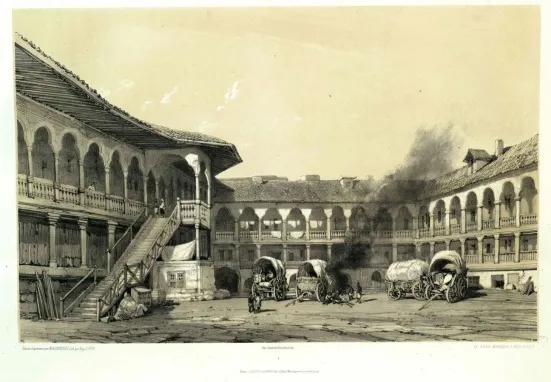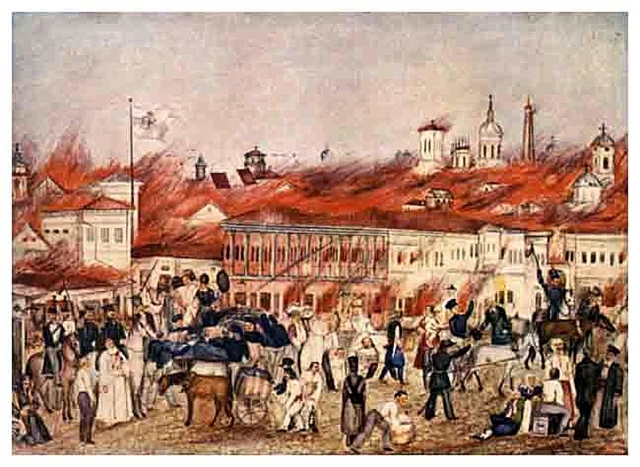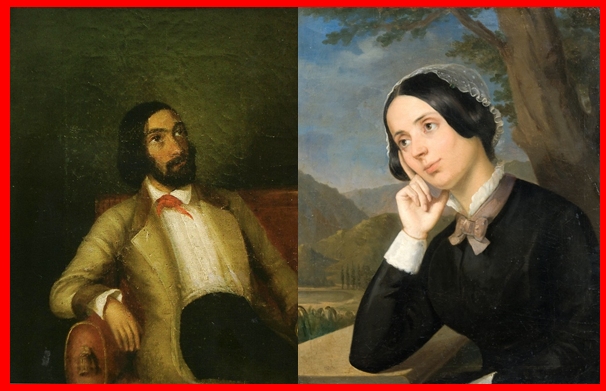‘None is happier than the poet for he lives twice, as a man and an angel. With the sole exception that through his earthly life he experiences nothing but happiness and candor. But what use is this material life to me, for when it offers me love, I feel unworthy to partake in it?’ These are the thoughts of young Rosetti of 24 years of age on the eve of the 1840’s Christmas.
What could have stirred such exaltation and upset in the heart of an educated young man descending from the princely Rosetti family and well on his way to become a literary and political leader, but love? Rosetti had just met Scot Mary Grant whose brother was Secretary to the British Consulate in (then) Wallachia.

Only one year later Rosetti reflects again on the importance of the weeding band. “How often have I dreamed of finding the one to whom I could gift this ring of faith. And how many haven’t demanded it from me? I told each and every one that it will be the last gift I’ll offer to a woman.” But is Scot Mary sharing the passionate ideals of this young eastern-European? And will a governess, the daughter of a ship-owning resident of the Island of Guernsey, be considered an appropriate match for the poor descendant of a family of boyars?
In his veins ran the Byzantine-Greek and Italian blood of his ancestors. Mary, at only 21 years of age, had arrived to Wallachia enchanted by her brother’s stories of this land and her own extensive reading. She had just settled as tutor of Colonel Ion Odobescu’s children, prepared to lead an independent life. Were Mary and Rosetti just as romantic, and will their ideals of life be enough to bring them together and see them through?
It was while their friendship budded that Rosetti ws forced to leave for Paris to further his studies and his political career. Will Mary wait for him? He sees her as an angel, and passionately asks her to promise that she’ll wait for him. A few years.
Sabina Cantacuzino, a friend of Mary’s family, describes her as: “ dark-skinned, not exactly beautiful, but with Mediterranean sex-appeal, expressive, passionate, artistic.” While away in Paris, Rosetti sees himself as… “a man with an ugly face”, but hopelessly in love with an angel. He sighs, and attended the courses of historians and thinkers such as Jules Michelet, Edgar Quinet, and other representatives of the French revolutionary spirit of that time.
While in Bucharest, Mary writes to him of her sadness, gazing out the window and reciting from Byron to sooth her longing heart. He cries out of happiness, and longing, and reads Romanian poets until, in in October 1946, convinced that he loses everything by not marrying the woman who loves him, he returns to Bucharest for a month… to gaze at her. On his return to Paris he made it only to Vienna. From there, he wrote to her and proposed. “It has been done,’ he penned in his diary, tormented, awaiting her reply, “Now she will make up her mind. I will either loose myself, or break free.”
She said yes. Yes!
What more happiness could they have dreamed of after finally being married on the 31st of August 1847 in Plymouth, and again united through an Orthodox wedding in Vienna?
Alas, a surprise awaited the young couple on their return to Bucharest. Their marriage was regarded by the new social climbers as… a misalliance. If any of these traditionalists had been clever enough to consult the Charter of Scottish Nobility, they would have been surprised to discover that the Grant family was ancient and held an important place in the British knighthood order.

Yet Mary was not a bride to be intimidated easily. With her refinement and intelligence she turned their social situation around, soon throwing the most thought-after reading soirees. As well as political meetings, determined as she was to understand the work and passions of her husband. ‘I am so happy to have married this woman,’ writes Rosetti, ‘With each passing day I love her more and more. My wife is superb, she is Michelet’s woman.’ (Meaning an accomplished wife, mother, and a loyalist with high moral standards’. Thus said the man who had received by now the 18th degree of Masonic Lodge, was a prefect of police in Bucharest, and owned a bookstore and a printing press together with his brother-in-law and others.
Only twenty years after the Revolution of Tudor Vladimirescu, Wallachia will soon be consumed by the Revolution of 1848.
During the months preceding the Romanian Revolution of 1848 Rosetti was one of the leaders of the radical current of the revolutionaries. Yet the revolutionary government was betrayed, and defeated. Rosetti and his party had been deceived by the Turks who soon proved to be in coalition with the Russian Empire. And one evening they were arrested. Gone. Condemned to exile, but where?
Mary knew nothing of her husband’s faith. Cradling her new-born girl named Liby, short for Liberty, Mary took to the streets among armed revolutionaries, hoping to find news of her beloved Rosetti. There, in the middle of the general exaltation, Mary cut bits of the tricolor scarf that her husband had worn during the first days of the Revolution, and shared the precious symbol to the people around her. What feeling of brotherhood she must have shared with her adopted nation!
Then the Turkish army entered the streets of Bucharest. 300 firemen stood against till they all died. What was Mary Rosetti to do? Some advised her to fight them, fight the Turks. And then what about her husband? Her brother promised her to have Rosetti and his men. They will be released from the Turkish prison in three days.
Three days came, then passed and Rosetti had not returned home. Where was he, only the birds in the sky knew. And the Russians who influenced the Turk officials who suddenly dropped months of negotiations with the Romanian revolutionaries.
So Mary took her faith into her own hands. By the evening, she sold as many of her priced possessions as she could, and kept the money. Dressed with only the clothes on her back and a blanket for her baby-daughter, she left under the cloak of the night in search (and release) of her beloved Rosetti. Only a family friend accompanied her, also a wanted man, Dimitrie Bratianu (who will later become the Prime Minister of Romania).
Where to? Towards Danube. And even the Ottoman Empire. She would even share captivity with her beloved husband.
How far? As far as it will take to find Rosetti.
When her trusted friend Bratianu was forced to flee to save himself, Mary Rosetti hugged her baby tighter and took to the country road on foot, through late spring rains and mud. But no cold cut deeper than her fear that she’ll never find her beloved husband again. At dawn, finally, the sight she was hoping for, Danube. And a ship with revolutionary prisoners! Mary ran along the shore, her eyes steady on that floating cell, her mind racing for a solution. Somehow, she met a medic she knew and he helped her visit the passengers aboard. Breathless, she hugged her husband and shared with the others the news she had from home. But the happy reunion was not meant to last. The prisoners were to be moved further. Where to? No matter where, she will follow them. For month, she took her babe and ran ahead of the ship, chasing like a happy thought, with horses galloping to the beat of her heart. And helping the arrested men with food, warm clothes, and moral encouragement.
All this during a time when, at least in eastern Europe, the man was considered as the head of his family, and the wife was perceived as a weaker being, with no material or moral rights.
The ship was now headed for another Danube harbor under Russian troops. While a Turkish soldier, taking pity on the young mother, had whispered one single word, revealing the dreaded faith that was awaiting the political prisoners, Bosnia!
There was only one thing to do. They will ask for help. Not from the English, nor the French, who looked the other way. But the help of the commoners who fought alongside them only months earlier, for a reunited Romania. Thus, when the ship reached Orşova harbor, Mary Rosetti and her babe headed for a nearby Romanian village, Svinița, whose people came to their rescue. And the prisoners were set free!
Finally, Mary and Rosetti were together and the young couple ran for their lives, living in Vienna, then in Germany, then France. And here, under the cover of literary soirees, Mary and Constantin Rosetti went on with their secret meetings. This time, the layout of a pro-Romanian newspaper. As their love for Romania, for a grand country, freed of any foreign ruling, the passion that united them in the first place, burned on. And Mary went on fighting firstly for the ideal and the rights of the Romanian people she had adopted and loved as her own, through her marriage with Rosetti.
Only in 1857, with Mary’s help gain, was Rosetti allowed to enter Romania. And only two years ahead of the Little Union, the unification of Moldavia and Wallachia under the ruling of Alexandru Ioan Cuza as prince of both the Principality of Moldavia and the Principality of Wallachia.
The story of Mary and Constantine Rosetti goes on, as their love and support for one another lasted until his tragic death. In the final days of his life Rosetti’s thoughts were still focused on his beloved Mary, “she made me love life so that, through my actions, to deserve her love.”

French painter C. D. Rosenthal left us a memento of Mary’s youth and of her passion and love for a united Romania through her 1850 portrait as ‘Revolutionary Romania’. Do you notice the Romanian blouse, ia, she’s wearing?
Mary Rosetti is remembered as a revolutionary, a passionate wife and mother, but also as the first Romanian female journalist.
Discover my books on Amazon.


Wow. A splendid post. It touched my heart. Loved reading it.
Thank you, Aparna 🙂 I believe that such stories give us inspiration and strength for moving forward.
Awww… ❤️ You were away for a while and I missed you. But you came back with such an endearing story. I’ve heard of Maria and Constantin Rosetti, of course, but I haven’t known anything about their beautiful love story.
Thank you, Jo.
I knew little of their love story too. And definitely nothing much of their involvement with the 1848 Revolution in Romania 😉
For me is the other way around. I knew nothing about their love story and some snippets of info regarding their historic importance. I mean, at least I knew about the painting. 🙂 So your post was informative from several points of view. Thank you!
Thank you, Jo. It is exiting to discover something else about something you thought you knew already 🙂 I think that at various moments in time / life we are ready to notice, and learn, about a different facet of the same story.
What a beautiful, inspiring story of love, Patricia – and such a wonderful poet.Toni x
I am so glad you enjoyed it, Toni 🙂
Beautiful story! I love a good love story.
Quite extraordinary. And such respect for one another 🙂
Inspiring.
This is the first time, Patricia, that I hear from this courageous and perseverant couple, or Mary and Constantine Rosetti, and thank you very much for telling it:)
Such a great pleasure, Martina. The high school I went to was named after him, Rosetti. But I was too young then to be interested in such details 🙂 And there’s a bridge in Bucharest named after her brother, Grant.
What a great story for Valentine’s day! What a great love story! Thanks for telling it.
Such a pleasure, Susan. I am glad it resonated with you.
Thank you 🙂
A fascinating story of love and tragedy, Pat. Thank you for sharing! Your posts are always well written and interesting. Keep up the good work.
Thank you so much, Mark!
I never heard this story before. Thanks for sharing!
Great pleasure, Dawn. 🙂
What a beautiful story. Love and bravery can turn mortals into saviors. There must be many stories like this one lost in the tides of time. Thank you for sharing such a powerful one, Patricia. 🙂
Thank you, Terveen 🙂 I am glad it inspired you.
Always a joy to see you.
What a beautiful story Patricia! First time I hear about Maria and Constantin Rosetti, thank you so much for sharing a piece of history with this story about love, support and overcoming difficulties.
Ah, thank you, Blanca 🙂
Thank you Patricia… that’s same how you do it